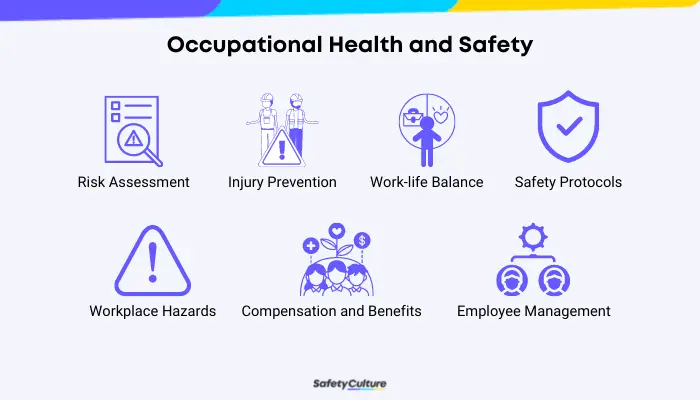What is Occupational Health and Safety?
Occupational Health and Safety (OHS), also known as Occupational Safety and Health (OSH), refers to the generic practice of addressing and reducing potential safety and health risks to employees. This can cover anything from risk assessment, injury prevention, work-life balance, safety protocols, workplace hazards, to compensation and benefits, and employee management.

Occupational Health and Safety (OHS)
The Value of Occupational Health and Safety (OHS)
Occupational safety is an important part of any business, as staff safety should always be prioritized before anything else. It’s the responsibility of employers to ensure that their staff are well-taken care of and are surrounded by as few risks as possible, so having guidelines in place for OHS can help them greatly.
A guide on OHS and having OHS standards in place will not only ensure a safe workplace and safe and healthy employees, but they could also lead to improvements in business as well. Studies in Europe show that workplace hazards and injuries not only have a physical cost on employees, but they have additional costs to companies as well. Employees getting sick and injured are costly to deal with for both the employees and their leaders, so preventing and mitigating them early on will save them both a lot of time and money. Good workplace conditions are also linked to more employee productivity, as employees are more likely to be motivated when they know they are cared for and are in a safe environment where they can work their best.
Create Your own OHS Checklist
Eliminate manual tasks and streamline your operations.
Get started for FREEDifferent OHS Practices Around the World
The World Health Organization (WHO) urges all employers to prioritize employee health and safety in the workplace at all times and for countries to create national plans and policies to support it. For this, some countries have created legal provisions for the implementation of OHS within their jurisdiction. These countries include the following:
United States
In 1970, the US passed the Occupational Safety and Health Act, which details the OHS standards to uphold in all workplaces for worker and environment safety. To properly enforce this across all 50 states, the National Institute for Occupational Safety and Health (NIOSH) was established for the Occupational Safety and Health Administration (OSHA) under the Department of Labor.
The OSH Act describes the common workplace hazards, how to address them, and the minimum safety protocols to follow in case of emergencies. It also provides standards for how employees should be compensated and what benefits they’re entitled to.
UK
In the UK, OHS standards are upheld by the Health and Safety Executive (HSE), which is sponsored by the country’s Department for Work and Pensions. Rather than a specific OHS law, the HSE implements the Health and Safety at Work etc. Act 1974 (HSWA), which has provisions for all things occupational safety.
Similar to the Occupational Safety and Health Act of the US, the HSWA details the guidelines for what should be the standard of health and safety in the workplace. Additionally, there are provisions for the duties of employers, the rights of employees, the purpose of having a medical advisory service in the workplace, and common hazards and how to address them.
Canada
In Canada, OHS is better known as OSH, and the guidelines for it are upheld by the Canadian Centre for Occupational Health and Safety (CCOHS). This was established in 1978 under the Canadian Centre for Occupational Health and Safety Act to create health and safety protocols that would promote a balanced state of well-being for all people in the workforce. The CCOHS also provides training, wellness programs, education, and solutions for companies to support their employees.
Meanwhile, all OHS resources can be accessed through a digital library they call the CanOSH. It’s a website created by the CCOHS where all provisions and regulations for workplace OHS in Canada are available for public viewing. This effort was made to promote workplace safety better so that employees on all levels are aware of the necessary laws to follow.
Australia
In Australia, OHS is more commonly known as Work Health and Safety (WHS). Each state in the country has its own WHS regulations to uphold, but they are all also required to follow the Safe Work Australia Act 2008 under the government agency Safe Work Australia. The act, as well as the acts respective to each state, details the proper safety protocols that all companies must maintain and includes the compensations and benefits that employees are entitled to receive in case of certain incidents and injuries.
France
In law no. 2021-1018 of August 2, 2021, France has strengthened occupational health prevention by providing companies and their employees benefits from a common set of services throughout the country. The Health at Work Act provides a minimum of 5 days of health, safety, and working condition training for the members of the social and economic committee (CSE).
The Ministry of Labor also collaborates with various research agencies to conduct risk assessments for certain tasks, hazards, and locations. Together with the National Agency for the Improvement of Working Conditions, occupational medical services, and occupational health officers, they work to advise companies on risk prevention.
Mexico
In Mexico, they do not have specific laws or government bodies regarding OHS. Rather than having one OHS act or body, OHS standards are set and implemented by their Federal Labor Law and Social Security Law. The Labor Law aims for all Mexican citizens to have a sustainable life by defining the relationship between employers and employees, what constitutes a safe working condition, and employee rights. On the other hand, the Social Security Law goes into detail on what employees’ rights are with regards to health and safety in the workplace.
Brazil
For OHS in Brazil, they have the Brazilian Regulatory Standards, which is also known as Norma Regulamentadora (NR). Their regulatory standards aim to establish and implement health and safety guidelines in the workforce and are periodically reviewed by the country’s Ministry of Labor and Employment.
Improve your EHS Management
Cultivate a safe working environment and streamline compliance with our EHS solutions.
Explore nowUsing SafetyCulture (formerly iAuditor) for Occupational Health and Safety
To ensure legal compliance with OHS standards and employee safety in the workplace, consider using a digital checklist to help you out. A digital checklist is a tool that can help you keep track of what regulations you are complying with easily, allowing you to view everything at a glance and continuously improve your Health, Safety, and Environment or HSE management system.
SafetyCulture is a digital checklist inspection app that allows managers and employers to keep track of the OHS guidelines to follow and track any issues they might find in the process. Through SafetyCulture, you can:
- conduct and schedule multiple inspections in different places all at once;
- store all checklists in one place;
- report any problems with compliance by raising Issues or assigning Actions to certain staff or groups;
- provide suggestions for changes in processes;
- attach photos and videos for proof of compliance; and
- create reports of the checklist’s findings.
SafetyCulture also allows you to create your own checklists and import your existing Excel, Word, or PDF ones. Additionally, SafetyCulture offers free checklist templates in their Public Library for you to use and edit as needed.




